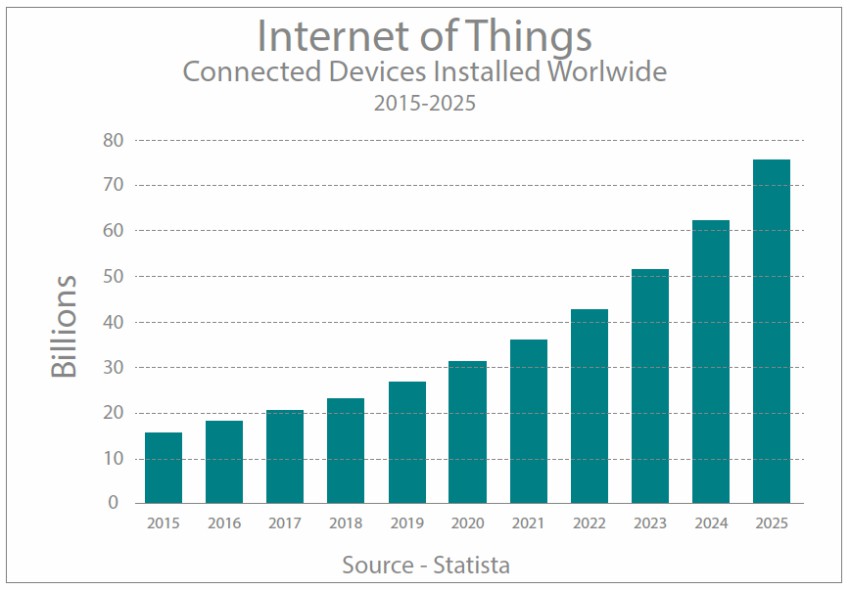Data management centers across Japan, the U.S. and beyond will depend on the high-performing, high-quality fiber optical technology that Sanwa has been supplying to the internet communications industry since the 1980s.

Over the coming years we will enter the age of ‘Ubiquitous Sensing’, where smart sensors will be attached to all sorts of “things”, from buildings, bridges, roads and cars to factory machinery, robots, domestic appliances and even our bodies. These sensors will be connected to computers through the internet, relaying huge amounts of analyzable data.
The Internet of Things (IoT) is here. If harnessed to its full potential, IoT will help businesses to improve productivity, efficiency and sales; it will allow cities to reduce traffic congestion, lower crime and cut energy and water consumption; it will enable farmers to improve yields and reduce waste; and it could help many of us to live healthier and perhaps happier lives.
IoT will be the main technology behind our smart cities, smart society and smart economies of the not-too-distant future. Consultancy firm, McKinsey, forecasts that applications of IoT could have a direct economic impact of between $2.7 trillion and $6.2 trillion per year by 2025. The biggest economic impact will be in healthcare, between $1.1 trillion and $2.5 trillion, while in manufacturing the impact is projected at between $900 billion and $2.3 trillion. McKinsey forecasts that the total operating cost of manufacturing will reach $47 trillion by 2025, and that IoT applications could save between 2.5% and 5% on operating costs, including maintenance and input inefficiencies.
There will be two main challenges for businesses and organizations adopting IoT technologies. The first is related to security. Having more devices connected to the internet naturally increases the risk of cyber threats from hackers. Businesses, governments and utility companies will need to put in place extensive cyber security measures to mitigate the risk of attack.
The other big challenge is related to data management. IoT-enabled devices will gather a huge amount of data. If this data is going to have any sort of direct benefit, enterprises will need to have both the human and technology resources in place to analyze it in real time, and then make ’smart’ decisions based on data analysis.
This is where Big Data comes in. Some of the best-positioned companies may be suppliers of big data and analytical software that can help extract meaning from the enormous flows of data that the Internet of Things will produce. The Internet of Things and Big Data are so closely intertwined; and there is no doubt that if used and managed properly the two areas will create new opportunities and solutions that will have a long and lasting impact on society, the environment and the economy.
“In recent years, the communications industry has been living through a series of transformative stages. With the rise of Industry 4.0 technologies such as Big Data ,Internet of Things and AI, an ever growing amount of information needs to be transmitted and shared through connected networks. Today, even changing a single signaling panel in a production line requires a large volume of data management,” says Sanwa president, Yasuo Ishii.
The emergence of IoT and Big Data represents major opportunities for Sanwa as a provider of fiber optical components that will be deployed in data management centers across Japan, the U.S. and beyond. These data management centers will be ground zero for IoT and Big Data, and as such, will depend on the high-performing, high-quality technology that Sanwa has been supplying to the internet communications industry since the 1980s.
“Since the beginning of the fiberoptic network decades ago, we have provided optical components, like our optical adapters and connectors, and technical services to data centers all over the world,” says Mr. Ishii.
“Beyond these components, we have begun expanding our offerings to include assembled solutions. One of these examples is our patch panels which provide flexible 4 or 6-port sub-assemblies that can easily be inter-changed or removed to significantly reduce the labor and potential errors in installation and servicing of data center cabinets.”
Sanwa initially sold these products on the Japanese domestic market only, where it took the opportunity to enhance its products and services before expanding into other markets worldwide. Today, many international Data management centers across Japan, the U.S. and beyond will depend on the high-performing, high-quality fiber optical technology that Sanwa has been supplying to the internet communications industry since the 1980s. Developing superior tech for data centers, the ground zero for IoT and Big Data clients are seeing the benefits of this Tokyo-based company’s technology over that of its competitors.
“A lot of these panels are offered by many manufacturers and utilized in data centers all over the world, but our solution offers the users with significant labor savings and more accurate installation,” says Mr. Ishii.
“In amusement parks and event venues for example, surveillance cameras and related devices generate massive amounts of data to manage the system and the attractions. Consequently, they employ an extensive data center network. Predominantly, those panels used in such facility were mostly overseas products, but our solutions are making significant progress in gradually replacing those current systems, helping users save more installation, operation and maintenance costs.”
0 COMMENTS